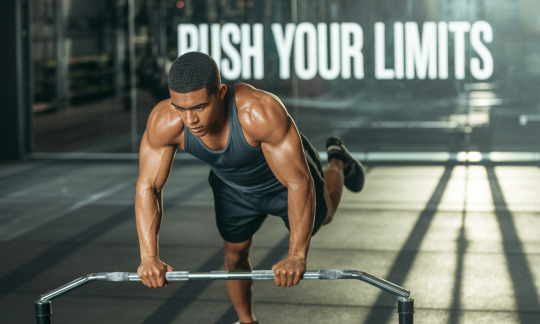#GameTimeStrategiesforFootballFans
Explore tagged Tumblr posts
Text
How to Train Like a Hybrid Athlete?

Hybrid athletes are the ultimate fitness chameleons, blending strength, endurance, and agility to excel in multiple disciplines. Think of someone crushing a deadlift, then running a 5K, all while looking like they could sprint up a mountain.
Training like a hybrid athlete isn’t just about being a jack-of-all-trades; it’s about building a body that’s strong, fast, and resilient.
Whether you’re eyeing CrossFit, obstacle races, or just want to be ready for anything, this article breaks down how to train like a hybrid athlete in four key areas: balancing strength and endurance, programming workouts, prioritizing recovery, and fueling performance. Get ready to unlock a versatile, all-around fitness game plan.
Balancing Strength and Endurance

Hybrid athletes thrive by being strong enough to lift heavy and enduring enough to go the distance. The trick is training both without burning out or neglecting one for the other. It’s not about maxing out bench presses one day and running marathons the next, it’s about smart integration.
Hybrid athletes typically aim to develop:
Mix modalities: Combine weightlifting (e.g., squats, deadlifts) with cardio (e.g., running, rowing) in the same week. Aim for 2-3 strength days and 2-3 endurance days.
Use circuits: Blend movements like kettlebell swings, burpees, or sled pushes to build strength and stamina in one session.
Vary intensity: Alternate heavy lifting days with lighter, longer cardio sessions to avoid overtraining.
Track progress: Monitor lifts and run times to ensure both are improving. Stalling in one area means adjusting your split.
Start with compound lifts like squats or bench presses to build raw power. Pair these with interval runs or bike sprints to keep your heart rate up. Avoid doing heavy lifts and long runs back-to-back; space them out to let your body adapt. Over time, this balance creates a physique that’s as durable as it is dynamic.
Programming Effective Workouts
A hybrid athlete’s workout plan is like a well-orchestrated playlist, varied, purposeful, and never boring. Programming workouts means structuring sessions to hit strength, endurance, and skill without overloading your system.
Here’s a sample weekly structure many hybrid athletes use:
Monday: Strength training (upper body focus)
Tuesday: Endurance (interval running or cycling)
Wednesday: Strength training (lower body focus)
Thursday: Active recovery (mobility work or light cardio)
Friday: Functional training + core work
Saturday: Long endurance effort (run, swim, bike)
Sunday: Rest or light mobility
A sample week might include a heavy squat day, a 5K run, a circuit of pull-ups and sprints, and a long, easy bike ride.
Mix modalities within sessions when possible, like pairing deadlifts with rowing intervals to mimic the demands of hybrid sports. Keep workouts under 90 minutes to stay fresh.
The goal is a plan that challenges every muscle and energy system without leaving you fried.
Prioritizing Recovery and Injury Prevention
Training like a hybrid athlete pushes your body hard, so recovery is non-negotiable. Without it, you’re flirting with burnout or injury, which can derail your progress. Recovery isn’t just crashing on the couch it’s active, deliberate, and strategic.
Effective recovery strategies include:
Sleep: Aim for 7–9 hours of high-quality sleep per night. Your body rebuilds during rest, especially after demanding workouts.
Nutrition: Fuel both performance and recovery with a balanced intake of carbs, protein, and healthy fats.
Mobility work: Stretching, foam rolling, and dynamic movements should be daily habits, not afterthoughts.
Deload weeks: Plan periods every 4–6 weeks where you reduce intensity and volume. This prevents burnout and promotes long-term gains.
Listen to your body. Soreness is normal, but sharp pain or constant fatigue means you’re overdoing it. Recovery isn’t slacking, it’s what makes the hard work stick.
Fueling Performance with Nutrition

Food is the fuel that powers a hybrid athlete’s engine. You need enough calories and the right nutrients to support heavy lifts, long runs, and everything in between. Nutrition isn’t about strict diets, it’s about consistency and balance.
Start with calories. Hybrid training burns a lot, so eat slightly above maintenance, think 15-20% more than your baseline. Protein is king; aim for 0.8-1 gram per pound of body weight daily to repair muscles.
Think chicken, eggs, fish, or plant-based options like lentils. Carbs fuel endurance. Oats, rice, or sweet potatoes are great for sustained energy. Fats, like avocado or nuts, support hormones and recovery.
Timing matters. Eat a carb-and-protein meal 2-3 hours before training, like a turkey sandwich or rice and salmon.
Post-workout, grab a shake or meal within an hour to kickstart recovery. Stay hydrated drink water throughout the day, and add electrolytes for long sessions in heat.
Supplements can help but aren’t magic. A protein powder or creatine can boost recovery, but whole foods come first.
Avoid cutting carbs or calories too low; underfueling tanks performance. Experiment to find what works, and tweak based on how you feel and perform.
Final Thoughts
To train like a hybrid athlete is to embrace a broader definition of fitness. It's not just about the heaviest lift or the fastest mile it's about doing both with competence and confidence. This kind of training rewards discipline, patience, and a genuine curiosity about human performance.
Hybrid athletes aren’t specialists. They’re modern-day generalists who can jump into almost any challenge and hold their own. And in a world that often rewards extremes, there’s something powerful about being impressively well-rounded.
If you're tired of rigid fitness categories or constantly flipping programs, hybrid training might just be the refreshing path you didn’t know you needed. It asks more from you but gives back even more in return.
Learning how to train like a hybrid athlete isn’t about following trends. It’s about building a foundation that lasts.
#BasketballBrosTapsintoPureNostalgia#HowtoTrainLikeaHybridAthlete#BalanceStrengthandStaminaLikeaHybridPro#GearThatHelpsYouPracticeWithouttheFuss#Apartment-FriendlyWorkoutsforSportsLovers#GameTimeStrategiesforFootballFans#UnderstandingFootball'sTime Thieves
1 note
·
View note